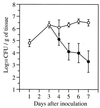New model of oropharyngeal candidiasis in mice
- PMID: 11600377
- PMCID: PMC90803
- DOI: 10.1128/AAC.45.11.3195-3197.2001
New model of oropharyngeal candidiasis in mice
Abstract
We established a straightforward murine model of oropharyngeal candidiasis. Mice were immunosuppressed with cortisone acetate, anesthetized, and then inoculated by placing cotton wool balls saturated with Candida albicans sublingually for 2 h. A prolonged, reproducible infection was induced. This model may be useful for antifungal screening or pathogenesis studies.
Figures




Similar articles
-
Mouse model of oropharyngeal candidiasis.Nat Protoc. 2012 Mar 8;7(4):637-42. doi: 10.1038/nprot.2012.011. Nat Protoc. 2012. PMID: 22402633 Free PMC article.
-
[Experimental oral candidiasis in healthy and immunocompromised BALB/c mice].Mikrobiyol Bul. 2011 Apr;45(2):336-43. Mikrobiyol Bul. 2011. PMID: 21644077 Turkish.
-
Antifungal activities of two new azasordarins, GW471552 and GW471558, in experimental models of oral and vulvovaginal candidiasis in immunosuppressed rats.Antimicrob Agents Chemother. 2001 Dec;45(12):3304-9. doi: 10.1128/AAC.45.12.3304-3309.2001. Antimicrob Agents Chemother. 2001. PMID: 11709301 Free PMC article.
-
Models hosts for the study of oral candidiasis.Adv Exp Med Biol. 2012;710:95-105. doi: 10.1007/978-1-4419-5638-5_10. Adv Exp Med Biol. 2012. PMID: 22127889 Review.
-
The role of yeasts other than Candida albicans in oropharyngeal candidiasis.Curr Opin Infect Dis. 2001 Dec;14(6):673-7. doi: 10.1097/00001432-200112000-00002. Curr Opin Infect Dis. 2001. PMID: 11964883 Review.
Cited by
-
Neutrophils Do Not Express IL-17A in the Context of Acute Oropharyngeal Candidiasis.Pathogens. 2015 Jul 24;4(3):559-72. doi: 10.3390/pathogens4030559. Pathogens. 2015. PMID: 26213975 Free PMC article.
-
Filamentation in Candida auris, an emerging fungal pathogen of humans: passage through the mammalian body induces a heritable phenotypic switch.Emerg Microbes Infect. 2018 Nov 28;7(1):188. doi: 10.1038/s41426-018-0187-x. Emerg Microbes Infect. 2018. PMID: 30482894 Free PMC article.
-
Host cell invasion by medically important fungi.Cold Spring Harb Perspect Med. 2014 Nov 3;5(1):a019687. doi: 10.1101/cshperspect.a019687. Cold Spring Harb Perspect Med. 2014. PMID: 25367974 Free PMC article. Review.
-
Development of Anti-Virulence Approaches for Candidiasis via a Novel Series of Small-Molecule Inhibitors of Candida albicans Filamentation.mBio. 2017 Dec 5;8(6):e01991-17. doi: 10.1128/mBio.01991-17. mBio. 2017. PMID: 29208749 Free PMC article.
-
Mucosal biofilms of Candida albicans.Curr Opin Microbiol. 2011 Aug;14(4):380-5. doi: 10.1016/j.mib.2011.06.001. Epub 2011 Jul 7. Curr Opin Microbiol. 2011. PMID: 21741878 Free PMC article.
References
-
- Gillum A M, Tsay E Y H, Kirsch D R. Isolation of the Candida albicans gene for orotidine-5′-phosphate decarboxylase by complementation of S. cerevisiae ura3 and E. coli pyrF mutations. Mol Gen Genet. 1984;198:179–182. - PubMed
-
- Klein R S, Carol A H, Small C B, Moll B, Lesser M, Friedland G H. Oral candidiasis in high-risk patients as the initial manifestation of the acquired immunodeficiency syndrome. N Engl J Med. 1984;311:354–358. - PubMed
-
- National Committee for Clinical Laboratory Standards. Reference method for broth dilution antifungal susceptibility testing of yeasts: approved standard. NCCLS document M27-A. Wayne, Pa: National Committee for Clinical Laboratory Standards; 1997.
Publication types
MeSH terms
Substances
Grants and funding
LinkOut - more resources
Full Text Sources
Other Literature Sources
Medical

